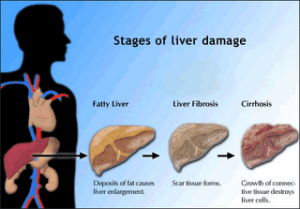Generally the condition of liver cirrhosis has been associated with excessive alcohol intake, and the victims have been adults.
A similar condition is the fatty infiltration of the liver, where the function becomes impaired through the growth of fatty tissue, which replaces healthy tissue. In its worst form this non-alcoholic fatty liver disease can advance to cirrhosis and end-stage liver disease. So far this devastating course of illness has been seen in adults, but it is not confined to the adult population. The most important risk factor for this disease is obesity, and with one in three children in Canada now overweight, the previous adult-only disease is now affecting kids. Non-alcoholic fatty liver disease is now the most common cause of abnormal liver tests.
Dr. Ariel Feldstein, a pediatric gastroenterologist from the Mayo Clinic in Rochester reports that the average age of children with these symptoms is about 12, which is an alarmingly low age for this picture. There is also a warning, that children do not even have to sport a sky-high body-mass index (BMI). The risk is already significant with a high BMI.The most direct approach to prevent type 2 diabetes and fatty-liver disease in children has to start within the family. Instead of singling out the child it is important to work together as a family to become healthier. The terms”fat”, “chubby”, “exercise” and “diet” are less conducive to improvement than “physical activity” and “better nutrition”. Consistent minor changes are also more important than crash diets that come and go.
Eating more vegetables and fruit, not eating and snacking mindlessly in front of the TV, eating together as a family and preparing healthy snacks instead of tossing a cookie bar or a bag of chips into the lunch bag are all ways that benefit the entire family.
A study from Dr. Robert Berkowitz at the Children’s’ Hospital of Philadelphia affirms even more, that prevention has to start with the parents: children born to overweight mothers have a higher risk of following the pattern of having a high body mass index than those whose parents were normal weight.
More information about liver cirrhosis: http://nethealthbook.com/digestive-system-and-gastrointestinal-disorders/liver-cirrhosis/
Reference: The Medical Post, February 15, 2005, page 21
Last edited October 27, 2014






